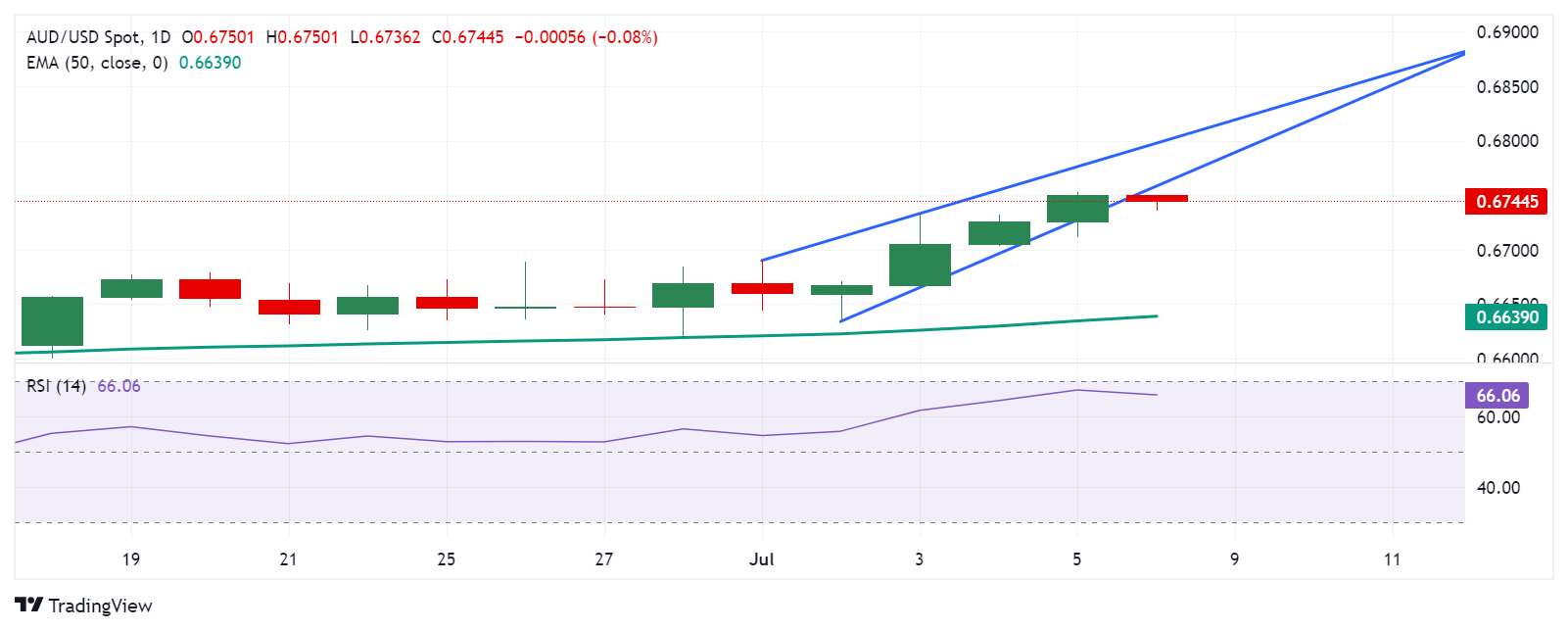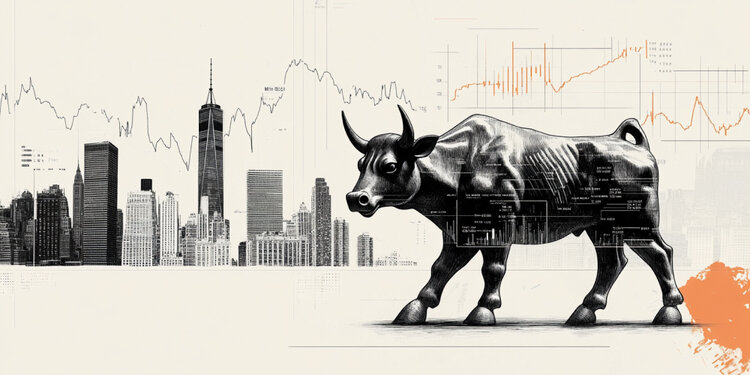- The Australian dollar could limit its decline as high inflation prompts the RBA to delay rate cuts.
- Australia’s May inflation has prompted warnings that the RBA could raise the cash rate to 4.6% in September.
- The US dollar could struggle as US job growth slows, which could lead the Fed to cut rates sooner.
The Australian Dollar (AUD) is retreating on risk aversion on Monday. Renewed demand for the US Dollar (USD) is putting pressure on the AUD/USD pair. The AUD may limit its downside due to persistently high inflation and stronger retail sales and services PMI. These factors could lead the Reserve Bank of Australia (RBA) to delay potential rate cuts.
Minutes from the RBA’s June meeting indicated that policymakers stressed the need to be alert to upside risks to inflation. Policymakers noted that a significant rise in prices could require substantially higher interest rates. Although rates remained stable in June, the May CPI, which surprisingly rose to 4.0% from 3.6% previously, prompted warnings that the RBA could raise the cash rate to 4.6% in September.
The US Dollar (USD) could face challenges as US job growth slowed in May, according to data released on Friday. Although Non-Farm Payrolls (NFP) beat market expectations in June, growth was slower compared to the increase in May. Also, the unemployment rate rose in June. This could lead traders to speculate that the Federal Reserve (Fed) could cut interest rates sooner than expected.
The CME’s FedWatch tool shows rate markets are pricing in a nearly 70.7% chance of a rate cut in September, up from 64.1% a week earlier.
Daily Market Drivers Roundup: Australian Dollar Falls on Risk Aversion
- US Nonfarm Payrolls (NFP) rose by 206,000 in June, following a rise of 218,000 in May. This figure exceeded the market expectation of 190,000.
- The US unemployment rate rose to 4.1% in June from 4.0% in May. Meanwhile, average hourly earnings declined to 3.9% year-over-year in June from the previous reading of 4.1%, in line with market expectations.
- Australia’s trade surplus for May was A$5.773 billion ($3.868 billion), lower than the A$6.678 billion expected and below the previous reading of A$6.548 billion, according to the Australian Bureau of Statistics on Thursday.
- Australia’s retail sales, a measure of consumer spending in the country, rose 0.6% month-on-month in May, up from a 0.1% increase in the previous month. This figure beat market expectations for a 0.2% rise.
- Judo Bank’s Australian services PMI rose to 51.2 m/m, up from 51.0 in the previous month, beating the expected drop to 50.6. Meanwhile, the composite PMI rose to 50.7 m/m, compared with 50.6 in the previous month.
- China’s services Purchasing Managers’ Index (PMI) fell to 51.2 in June from 54.0 in May, according to the latest data released by Caixin on Wednesday. The market forecast was for a reading of 53.4 in the reporting period.
- Federal Reserve Bank of Chicago President Austan Goolsbee said on BBC Radio on Wednesday that getting inflation back to 2% will take time and that more economic data is needed. However, on Tuesday, Fed Chair Jerome Powell said the central bank is returning to a disinflationary path, according to Reuters.
Technical Analysis: Australian Dollar Holds Its Position Around 0.6750
The Australian Dollar is trading around 0.6740 on Monday. The daily chart analysis shows that the AUD/USD pair is breaking below a rising wedge, which indicates a possible bearish reversal. Moreover, the 14-day Relative Strength Index (RSI) is consolidating slightly below the 70 level. A downward move in the RSI would suggest that the asset could experience a correction.
The AUD/USD pair is likely to test the lower boundary of the ascending wedge around 0.6755, followed by the psychological level of 0.6800 near the upper boundary of the wedge.
On the downside, the AUD/USD pair could navigate the region around the 50-day exponential moving average (EMA) at 0.6639.
AUD/USD: Daily Chart
Australian Dollar PRICE Today
The table below shows the Australian Dollar (AUD) exchange rate against major currencies today. The Australian Dollar was the weakest currency against the Japanese Yen.
| USD | EUR | GBP | JPY | CAD | AUD | NZD | CHF | |
|---|---|---|---|---|---|---|---|---|
| USD | 0.11% | 0.04% | -0.13% | -0.07% | 0.04% | -0.11% | -0.08% | |
| EUR | -0.11% | 0.14% | 0.09% | 0.15% | 0.08% | 0.12% | 0.15% | |
| GBP | -0.04% | -0.14% | -0.08% | 0.02% | -0.05% | -0.03% | 0.01% | |
| JPY | 0.13% | -0.09% | 0.08% | 0.06% | 0.18% | 0.18% | 0.11% | |
| CAD | 0.07% | -0.15% | -0.02% | -0.06% | 0.06% | -0.04% | 0.01% | |
| AUD | -0.04% | -0.08% | 0.05% | -0.18% | -0.06% | 0.04% | 0.08% | |
| NZD | 0.11% | -0.12% | 0.03% | -0.18% | 0.04% | -0.04% | 0.03% | |
| CHF | 0.08% | -0.15% | -0.01% | -0.11% | -0.01% | -0.08% | -0.03% |
The heatmap shows percentage changes of major currencies. The base currency is selected from the left column, while the quote currency is selected from the top row. For example, if you choose the Australian Dollar from the left column and move along the horizontal line to the US Dollar, the percentage change shown in the chart will represent the AUD (base)/USD (quote).
Australian Dollar FAQs
One of the most important factors for the Australian Dollar (AUD) is the level of interest rates set by the Reserve Bank of Australia (RBA). Since Australia is a resource-rich country, another key factor is the price of its largest export, iron ore. The health of the Chinese economy, its largest trading partner, is a factor, as is inflation in Australia, its growth rate and the Trade Balance. Market sentiment, i.e. whether investors are betting on riskier assets (risk-on) or seeking safe havens (risk-off), is also a factor, with risk-on being positive for the AUD.
The Reserve Bank of Australia (RBA) influences the Australian Dollar (AUD) by setting the level of interest rates that Australian banks can lend to each other. This influences the level of interest rates in the economy as a whole. The RBA’s main objective is to maintain a stable inflation rate of 2%-3% by adjusting interest rates up or down. Relatively high interest rates compared to other major central banks support the AUD, and the opposite for relatively low ones. The RBA can also use quantitative easing and tightening to influence credit conditions, with the former being negative for the AUD and the latter positive for the AUD.
China is Australia’s largest trading partner, so the health of the Chinese economy greatly influences the value of the Australian Dollar (AUD). When the Chinese economy is doing well, it buys more raw materials, goods and services from Australia, which increases demand for the AUD and drives up its value. The opposite occurs when the Chinese economy is not growing as fast as expected. Therefore, positive or negative surprises in Chinese growth data often have a direct impact on the Australian Dollar.
Iron ore is Australia’s largest export, worth $118 billion per year as of 2021 data, with China being its main destination. The price of iron ore can therefore be a driver of the Australian dollar. Typically, if the price of iron ore rises, the AUD rises as well, as aggregate demand for the currency increases. The opposite occurs when the price of iron ore falls. Higher iron ore prices also tend to lead to a higher probability of a positive trade balance for Australia, which is also positive for the AUD.
The trade balance, which is the difference between what a country earns from its exports and what it pays for its imports, is another factor that can influence the value of the Australian dollar. If Australia produces highly sought-after exports, its currency will gain value solely because of the excess demand created by foreign buyers wanting to purchase its exports compared to what it spends on buying imports. Therefore, a positive net trade balance strengthens the AUD, with the opposite effect if the trade balance is negative.
Source: Fx Street
I am Joshua Winder, a senior-level journalist and editor at World Stock Market. I specialize in covering news related to the stock market and economic trends. With more than 8 years of experience in this field, I have become an expert in financial reporting.








